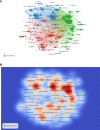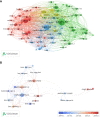Global research trends and hotspots on glioma stem cells
- PMID: 36248966
- PMCID: PMC9558893
- DOI: 10.3389/fonc.2022.926025
Global research trends and hotspots on glioma stem cells
Abstract
Background: Glioma stem cells (GSCs) are a sub-population of cancer stem cells with capacity of self-renewal and differentiation. Accumulated evidence has revealed that GSCs were shown to contribute to gliomagenesis, distant metastasis as well as the resistance to radiotherapy and chemotherapy. As a result, GSCs were regarded as a promising therapeutic target in human glioma. The purpose of our study is to identify current state and hotspots of GSCs research by analyzing scientific publications through bibliometric methods.
Methods: All relevant publications on GSCs during 2003-2021 were extracted from the Science Citation Index Expanded of Web of Science Core Collection (WoSCC), and related information was collected and analyzed using Microsoft Excel 2016, GraphPad Prism 8 and VOSviewer software.
Results: A total of 4990 papers were included. The United States accounted for the largest number of publications (1852), the second average citations per item (ACI) value (67.54) as well as the highest H-index (157). Cancer Research was the most influential journal in this field. The most contributive institution was League of European Research Universities. RICH JN was the author with the most publications (109) and the highest H-index (59). All studies were clustered into 3 groups: "glioma stem cell properties", "cell biological properties" and "oncology therapy". The keywords "identification", "CD133" and "side population" appeared earlier with the smaller average appearing years (AAY), and the keywords"radiotherapy" and "chemotherapy" had the latest AAY. The analysis of top cited articles showed that "temozolomide", "epithelial-mesenchymal transition", and "immunotherapy" emerged as new focused issues.
Conclusion: There has been a growing number of researches on GSCs. The United States has always been a leading player in this domain. In general, the research focus has gradually shifted from basic cellular biology to the solutions of clinical concerns. "Temozolomide resistance", "epithelial-mesenchymal transition", and "immunotherapy" should be given more attention in the future.
Keywords: EMT - epithelial to mesenchymal transformation; bibliometric analysis; chemotherapy resistance; glioma stem cell (GSC); hotpots.
Copyright © 2022 Song, Wu, Wang, Jiao, Xu, Wang, Tong and Yan.
Conflict of interest statement
The authors declare that the research was conducted in the absence of any commercial or financial relationships that could be construed as a potential conflict of interest.
Figures








Similar articles
-
Global research landscape and trends of cancer stem cells from 1997 to 2023: A bibliometric analysis.Medicine (Baltimore). 2024 May 17;103(20):e38125. doi: 10.1097/MD.0000000000038125. Medicine (Baltimore). 2024. PMID: 38758889 Free PMC article.
-
Bibliometric Analysis of Global Research Trends on Ultrasound Microbubble: A Quickly Developing Field.Front Pharmacol. 2021 Apr 22;12:646626. doi: 10.3389/fphar.2021.646626. eCollection 2021. Front Pharmacol. 2021. PMID: 33967783 Free PMC article.
-
Publication trends and hotspots of drug resistance in colorectal cancer during 2002-2021: A bibliometric and visualized analysis.Front Oncol. 2022 Aug 30;12:947658. doi: 10.3389/fonc.2022.947658. eCollection 2022. Front Oncol. 2022. PMID: 36110958 Free PMC article.
-
Bibliometric analysis of global scientific activity on umbilical cord mesenchymal stem cells: a swiftly expanding and shifting focus.Stem Cell Res Ther. 2018 Feb 7;9(1):32. doi: 10.1186/s13287-018-0785-5. Stem Cell Res Ther. 2018. PMID: 29415771 Free PMC article. Review.
-
Research trends of glioma-related epilepsy: A bibliometric analysis from 2004 to 2023.J Cent Nerv Syst Dis. 2024 Oct 16;16:11795735241286653. doi: 10.1177/11795735241286653. eCollection 2024. J Cent Nerv Syst Dis. 2024. PMID: 39420955 Free PMC article. Review.
Cited by
-
Trends of mapping knowledge structure and themes of cancer sonodynamic therapy: a text-mining study.Quant Imaging Med Surg. 2024 Dec 5;14(12):8734-8757. doi: 10.21037/qims-24-128. Epub 2024 Nov 29. Quant Imaging Med Surg. 2024. PMID: 39698701 Free PMC article.
-
Mapping Knowledge Structure and Themes Trends of Ewing Sarcoma: A Text-Mining Study.Ann Surg Oncol. 2025 May;32(5):3724-3740. doi: 10.1245/s10434-025-16978-7. Epub 2025 Feb 19. Ann Surg Oncol. 2025. PMID: 39971856
-
Global research landscape and trends of cancer stem cells from 1997 to 2023: A bibliometric analysis.Medicine (Baltimore). 2024 May 17;103(20):e38125. doi: 10.1097/MD.0000000000038125. Medicine (Baltimore). 2024. PMID: 38758889 Free PMC article.
-
Visualization of the relationship between macrophage and wound healing from the perspective of bibliometric analysis.Int Wound J. 2024 Apr;21(4):e14597. doi: 10.1111/iwj.14597. Epub 2023 Dec 20. Int Wound J. 2024. Retraction in: Int Wound J. 2025 Apr;22(4):e70670. doi: 10.1111/iwj.70670. PMID: 38124467 Free PMC article. Retracted.
-
Mapping knowledge landscapes and emerging trends of Marburg virus: A text-mining study.Heliyon. 2024 Apr 15;10(8):e29691. doi: 10.1016/j.heliyon.2024.e29691. eCollection 2024 Apr 30. Heliyon. 2024. PMID: 38655363 Free PMC article.
References
LinkOut - more resources
Full Text Sources
Research Materials

